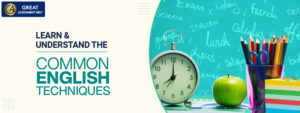When it comes to effective communication, English techniques play a crucial role. Metaphors, imagery, and repetition are some techniques that will help writers and speakers convey their message more effectively. By mastering English techniques, you can add depth, emotion, and clarity to your language and make your work more engaging, persuasive, and memorable.
The beauty of a language lies in its features. To creatively narrate a poem, a story, a play, or any other form of content, writers and poets extensively use Language Techniques. Also, with language techniques, you can create any kind of content that belongs to both the formal and informal categories. In English, there are many language features and literary elements available. If you have good knowledge about the list of English Language Techniques, then you can implement them effectively in your work and can also understand the work of other writers who have used those techniques.
Do you know about English techniques? If not, then it’s time for you to learn! Here, in this post, we will let you know what English techniques are, their purposes, and a common list of English language techniques you can use while writing or speaking.
What are English Techniques?

English techniques are techniques that give artistic value to a text. It is used predominantly by writers to highlight an important thing in a text or to convey the meaning of something implicitly or explicitly.
Benefits of Using English Techniques
So, why should a person use English techniques in their work? What is the Importance of Grammar in English? Here is a clarification for you!
Generally, writers, poets, and students who have deep knowledge of the language use English techniques to
- Give life to a story
- Effectively convert thoughts into words
- Make the content recognizable and understandable to the readers
- Add poetic flavor to the content
- Help the readers visualize content
List of Common English Techniques
Figures of speech and literary devices are parts of English techniques that are used to convey a message or the meaning of a text. There are numerous English Language Techniques available to help you improve the text’s richness. Let us now proceed to the list of common English techniques that you should be aware of and learn with examples.
Read more: LITERARY RESEARCH TOPICS – TO GAUGE IN THE LITERATURE
Allusion
It is a figure of speech that refers to something without mentioning it explicitly. In simple terms, it is an indirect reference. The authors generally allude to politics, history, culture, and other literary works.
Example: That guy was romantic and a true Romeo
This sentence alludes to Romeo and Juliet, written by William Shakespeare. Here, that guy’s personality is referred to as the romantic nature of Romeo.
Alliteration
The repetition of the same consonant sound at the start of multiple words in a single sentence or a group of sentences is called Alliteration.
Example: Peter Piper picked a peck of pickled peppers.
Assonance
The repetition of vowel sounds within a sentence is called Assonance. It is a common literary technique used by poets when composing poetry.
Example: Go slow on the road
Allegory
It is a kind of text that has a different meaning than the literal meaning. Allegories are generally used to express moral or political situations.
Example: George Orwell’s Animal Farm is an allegorical novel about communism. In the novel, all the animals on the farm represent members of the communist society.
Anaphora
It is the repetition of a word or a phrase at the start of multiple sentences or lines. It is a kind of rhetorical device that writers and orators use to emphasize their message or words.
Example: With malice towards none; with charity for all; with firmness in the right…
Characterization
Describing a character throughout a text is called Characterization. In simple terms, characterization is the description of a character’s personality, physical traits, thoughts, opinions, and actions. It can be done both directly and indirectly.
Example: Jane is a bold and beautiful girl who loves to take risks in life.
Emotive Words
The words used by the writers to evoke an emotional response from the readers are called Emotive Words. The authors use emotive words to grab the attention of the readers.
Example: “A giant truck viciously crushed the poor biker” is more emotive than “A Truck hit a biker.”
Foreshadowing
It is a kind of language technique that the narrators or writers use to give hints about certain things or events at the beginning, which will later occur meaningfully in the story. It is a kind of “preview”.
Example: In chapter two, Fred mentions that he’s allergic to peanuts. In chapter nineteen, he accidentally eats some food with peanuts and almost dies.
Genre
It is a category of a story. Some common genres include romance, fiction, science fiction, fantasy, and crime. The elements like mood, theme, and style contribute to the genre.
Example: Twilight is a fantasy movie.
Juxtaposition
It is a literary technique that compares and contrasts two different objects or concepts.
Example: Beggars can’t be choosers. Here, ‘beg and choose’ are contrasting functions, and this proverb implies that one cannot be both desperate and have any choice in the decision.
Metonymy
It is an act of referring to something with a closely related object instead of its own name.
Example: Crown refers to the power of a king.
Metaphor
It is one of the common poetic devices that authors use while writing poems and literature. Metaphors are nothing but words or phrases that describe something in a literally untrue way.
Example: Love is a battlefield.
In this sentence, love is compared to a place where a fight happens.
Onomatopoeia
These are words that give a vibe of a sound. Authors use this technique to make the audience feel the action. Some examples of Onomatopoeia include giggle, sprinkle, grunt, drizzle, etc.
Example: He banged the door and left.
Personification
Personification is a common literary technique that poets and storytellers use to represent objects or non-living things in the form of humans.
Example: My alarm shouted at me in the morning.
Parody
It is a spoof, meaning an imitation of a particular text style humorously.
Example: Pride and Prejudice and Zombies is a book that incorporates zombies into Jane Austen’s world.
Pun
It is a humorous play with words that gives multiple meanings to a sentence.
Example: Why are teddy bears not hungry? They are always stuffed.
Sarcasm
It is a kind of verbal irony. In simple terms, sarcasm means using words opposite to someone’s actual feelings.
Example: I love getting stuck in traffic.
Satire
Satire refers to the usage of humor to expose and criticize a person’s stupidity. This technique is often used as a call to action to create social change. The writers use satire in the context of topical issues or contemporary politics.
Example: The Onion is a popular satirical online news site that embodies Horatian satire.
Simile
It is a figure of speech that poets use to compare two different things using ‘like’ or ’as’.
Example: He ran as fast as a Cheetah.
In this sentence, the running speed of a man is compared with a cheetah’s speed.
Symbol
A Symbol denotes an object that has a deeper meaning in a text. Generally, colors, sounds, places, and flowers are used as symbols.
Example: White symbolizes peace.
Tone
It is a mood in a text. The writers use tone to express their opinions about a subject. The tone can be positive or negative, meaning it can be happy, sad, professional, satirical, etc.
Example: A journalist should write the news article in a neutral tone because they should not inject their opinions about an event into the reader’s mind.
Zeugma
It refers to the usage of a word that has multiple meanings in the same sentence for different phrases.
Example: He lost his wallet and his mind. Here, ‘lost his wallet’ means he misplaced his wallet, and ‘lost his mind’ means he went aggravated.
The Bottom Line
We hope you have gained a better understanding of the common English techniques. Here, in this blog post, we have presented only a few English Techniques, but there is still a lot. To learn more about English techniques, read great authors’ work, and conduct a language analysis. Otherwise, you can also take our English assignment help services. The expert from our team will assist you in improving your English knowledge. Furthermore, they will guide you in dealing with all types of assignments that are related to English.



